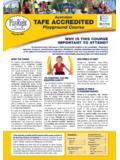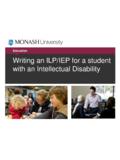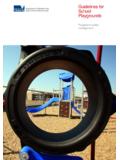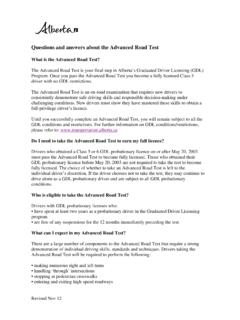Transcription of Supervision Policy Linked to National Quality …
1 Supervision Policy Linked to National Quality standards - Quality Area Two and Five Policy statement Feng Holdings trading as Tanah Merah Child Care Centre (referred throughout this Policy as the service ) has a duty of care to provide all persons with a safe and healthy environment. The service defines Supervision as the act of watching, listening and instructing children within the service to ensure their safe, engaged and learning about the world in which they live. The service s Supervision Policy is committed to: o complying with the Child Care Regulations 2002 and Act 2003 adult/child ratios; o ensuring that children are supervised at all times; o considering the design and arrangement of children s environments to support active Supervision ; o using Supervision skills to reduce or prevent injury or incident to children and adults; o guiding educators to make decisions about when children s play needs to be interrupted and redirected.
2 O supporting educators and their caregiving strategies; o providing consistent Supervision strategies when the service requires relief educators; and o acknowledging and understanding when Supervision is required for high risk experiences and/or the ratio of adults to children is increased. It is understood that there is a shared legal responsibility and accountability between, and a commitment by, all persons to implement the service s Supervision Policy , procedures and practices. The service also complies with Workplace Health and Safety Act 1995 and best practice recommendations from recognised authorities.
3 The procedures relating to the Supervision Policy are laminated clearly labelled and displayed in the service for all stakeholders to read. Rationale Feng Holdings trading as Tanah Merah Child Care Centre strive to provide an environment where children are in sight or sound of a educators at all times. Educators will endeavour to ensure that are aware of all children s movements both during indoor and outdoors. Strategies and practices Principles of active Supervision Supervision is one of the most important care giving strategies and skills required by educators to develop and master.
4 Active Supervision is a combination of listening to and watching children play, being aware of the environment and its potential risks, the weather conditions, the time of day, managing small and large groups of children, and an understanding of child development including theories about how children play. It is also crucial that educators are aware of the different ages, personalities, behaviors and characteristics of the children in their care. How children interact, communicate and play with one another is dependent on educators building relationships with children to learn about who they are, how they react in certain situations and discover their interests.
5 These are vital skills to develop as they assist educators to predict children s play patterns, which affects how educators plan and establish environments and coordinate Supervision strategies to maximise children s safety and ability to play free from harm or injury. Positioning of educators in the environment When supervising children educators need to consider how they position themselves both in the outdoor and indoor environment. Educators need to consider: -Do I have my back to any of the group?
6 -Are new or high risk experiences being introduced and where will I stand / sit during these experiences? -Is their a student / volunteer to be considered? -Are there corners or areas which children may play in that pose a risk? Scanning the environment and knowing the number of children Scanning is vitally important when supervising children. Educators are required to regularly scan when children sleeping, especially outdoors and babies in cot rooms; regular checking of older children in outside school hours care who may not be being directly supervised.
7 Educators need to develop a system of regular head counts marking each child s arrival and departure to ensure that they are fully aware of where each child is at all times. Educators should also have a list of people who are authorized to pick up each child from the service and information regarding those people not allowed to collect a child. Educators need to ensure that this documentation remain confidential. Listening when children play Listening is also important educators need to be aware of children and the noises they make.
8 For example, water splashing; crying; choking or gasping; offensive or aggressive language; or silence. Setting up the environment During playground set-up please be aware where children will be and how they will use the equipment for Supervision . Grouping equipment together such as easels and water troughs makes Supervision much easier. Knowledge of the children in care and understanding how groups of children interact and play together. Educators need to be reflect of the age groups being supervised.
9 Observing children s play and anticipating what may happen next will assist children when difficult situations arise and to intervene where there is potential danger to children. Children with early signs of illness or atypical behaviours should be monitored closely, this is extremely important when supervising children who known medical conditions. Keep children s developmental records up to date so that as a educators you are aware of a child s capabilities and the appropriate level of challenge can be made to the playground to enhance their development.
10 Transitioning groups of children Supervision during transitions is vitally important and often complex, there may be many things needy to be ready and organisation is the key. Educators need to reflect: o When and where are children transitioned throughout the day? o What can organize early so children are not left waiting? o Are there potential risks when transitioning children? How can the service develop risk management strategies to eliminate or reduce the potential risks? For example, transitioning children from the parked car or bus to the service s entrance.






